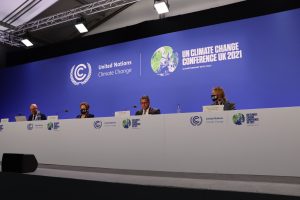As the climate crisis continues to accelerate, our window of opportunity to act is closing fast. As humanitarians, we strive to protect and preserve life on our earth, yet too often our response to address the immediate needs of affected populations comes at the cost of damage and harm to the environment and climate.
With the impacts from climate inaction and environmental degradation set to inflict profound consequences upon humanity and the health of our planet, exacerbating existing humanitarian needs and generating new ones, our sector must make environmental sustainability integral to our operations. As part of our Humanitarian Horizons 2021-2024 research program, our ‘Greening the System’ stream seeks to guide the humanitarian sector to reduce its negative impacts on the environment, and tangibly move towards a greener response.
The recent publications of the Intergovernmental Panel on Climate Change’s (IPCC) Sixth Assessment Report have made clear that climate change is already causing deep harm to populations, ecosystems, and biodiversity. Its findings detail continued trends of global warming and the threat this poses to everyday life: exacerbating conflict, compounding the effects of poor infrastructure, and destabilising daily life. The IPCC has urged drastic action to halt carbon dioxide emissions and called for more to be spent on adaptation and innovation.

In truth, though, we didn’t need another report that further puts our future under a bleak microscope: the impacts of climate change and environmental degradation are already well upon us. Climate and weather-related disasters have increased five-fold over the past 50 years, contributing to the displacement of 10.3 million people in just six months during 2020-21. A decade of droughts in Somalia has caused 2.3 million people to face severe food and water insecurity, while over 57 million people were affected by climate-related disasters in 2021 alone across Asia and the Pacific. There is a chance of global temperatures reaching 1.5 degrees C in the next five years, after which one more 1 degree (which we have not yet acted to avoid) will create needs for an estimated additional $1 trillion in annual humanitarian spending. And these impacts will be felt unequally. Climate change is affecting lower income countries with fewer resources to adapt than middle- and high-income countries and exacerbates the existing vulnerabilities of people living in poverty and conflict-affected areas. The Notre Dame Global Adaptation Initiative (ND-Gain) Index shows that of the 25 countries currently deemed most vulnerable to climate change, 14 are experiencing internal conflict. Meanwhile, studies [1, 2, 3] have drawn attention to how climate-induced socio-economic deterioration can fuel conflict and civil unrest. The World Bank warns the number of climate migrants could reach 216 million by 2050, a figure that could be reduced by 80% through collective global adaptation and mitigation processes.
Yet, despite the desperate need for everyone to take action, the humanitarian sector continues to contribute to our changing climate and environmental harm. Infamously, emissions from the humanitarian response to the 2010 Haiti Earthquake reached near that of the host country’s annual emissions. More recently, shelter operations for Rohingya refugees in Bangladesh resulted in 3000-4000 acres of deforestation – contributing to loss of natural carbon sinks and habitat decline. The reliance on diesel-produced energy to power operations, large-scale use of plastic packaging, heavy logistics, and frequent flights, create a sizable carbon footprint from the sector. A lack of sector-wide emissions reporting (particularly on indirect or scope 3 emissions) has reduced scrutiny and incentive for change. Recently, a study by the New Humanitarian surveyed 24 international aid organisations and determined a concerning shortage of hard organisational policy and emissions reduction commitments among many of the sector’s biggest actors.
Nonetheless, it is clear that recognition of the issue is increasing. The International Red Cross and Red Crescent Movement (IFRC and ICRC), DG-ECHO and ACTED are notable frontrunners, while restoration groups such as the World Wildlife Fund (WWF) and the International Union for Conservation of Nature (IUCN) have offered toolkits to help guide environmentally sustainable action, aiming to bridge the existing divide between humanitarian and environmental or conservation focussed organisations.
Despite the emerging good practice, however, concerted efforts across the wider sector remain lacking, and barriers persist in the forms of competing priorities or de-prioritisation, underfunding and an overarching lack of urgency to centralise the climate crisis within humanitarian priorities. The perceived trade-off between saving lives and protecting the environment is the most widely cited barrier to more significant action. We no longer have the time or luxury to consider this a trade-off. Protecting the environment during humanitarian responses is a live-saving imperative. The consequences for humanity as a result of climate change make clear that addressing the climate crisis is central to humanitarian principles.
Greening our system requires environmentally sustainable action from the ground up – from our operations to our offices, including the major blind spot of indirect emissions. A green response must be guided by local voices and indigenous knowledge, while we must ensure that environmental consideration is systematically channelled into all facets of our operations. It can not be the responsibility of individuals or specific organisations – we need to transcend the engrained siloes and ensure that we are all individually, institutionally, collectively and systematically accountable for protecting the climate and the environment. As humanitarian actors, we are the best equipped to act fast in the face of crisis, and we must now work collectively to ensure our operations will protect and preserve life both now and in the future.
Humanitarian Advisory Group’s Greening the System research stream aims to explore the links between humanitarian action and climate change, and offer guidance for the sector to collectively move towards a greener response. Our vision paper which commences our research journey will be released in the coming weeks. As part of our social purpose and as a certified B Corporation, Humanitarian Advisory Group has committed to becoming NetZero by 2030.
Photo credit: Ashish_wassap6730 & Paul Adepoju (Shutterstock)






